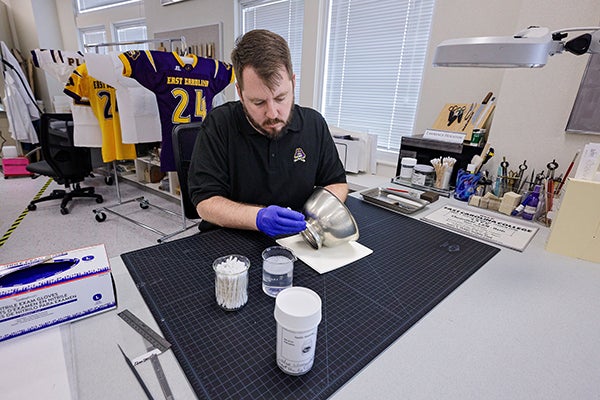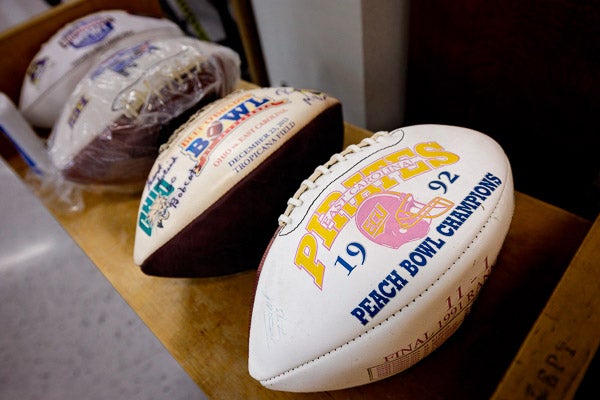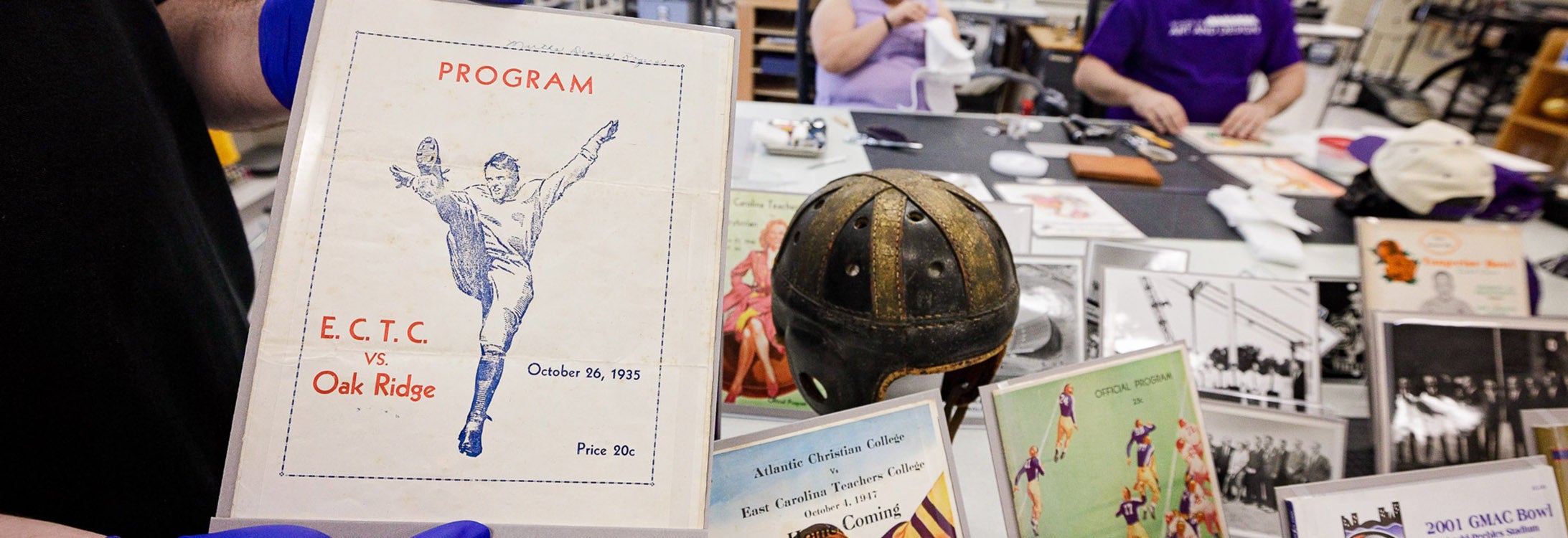NO QUARTER
Library exhibit details decades of Pirate football moments, memorabilia
The contract for the first paid East Carolina University head football coach was signed in 1934 on the back of a postcard. ECU’s only undefeated season was a 7-0 record in 1941, including a victory over the Norfolk Naval Hospital team before no games were played from 1942-45 amid World War II.
The 1963 Eastern Bowl trophy, from the Pirates’ first bowl win, is made of pewter and includes the East Carolina College institutional seal. A 1964 preseason playbook featured plays to memorize preceded by a list of wide-ranging player expectations from coach Clarence Stasavich.
In all, there is no shortage of facts and artifacts to enjoy about ECU football in Academic Library Services’ exhibition “No Quarter: The History of East Carolina Football and Dowdy-Ficklen Stadium.”
This exhibit opens Aug. 1 and will be displayed on the main campus library’s second and third floors into November. An item as recent as a coach Mike Houston-signed game ticket from the Pirates’ 53-29 win over Coastal Carolina at the Birmingham Bowl on Dec. 27, 2022, is highlighted. One of the interactive components is game video from the 1970 ECU-Marshall matchup in Greenville.
“The majority of what we have are items that were loaned from community members, including one individual who gave me upwards of 160 items,” said Patrick Cash, manuscripts curator and lead on the exhibit project.
ECU video by Bryan Edge. Watch the video with closed captions on YouTube.
“You see that passionate fan base that’s been there since the beginning. I’ve talked to some alumni pushing in their (age) 80s and they talk just as fondly about the football team and program then as students and fans do now. … They love their Pirates. The other thing is learning how far the history goes back.
“It’s a very rich and in-depth history. I think the history of the football team ties in so well with the history of the university.”
Team effort
Cash first got the idea for the exhibit in 2020 while working in university archives researching ECU football. Targeting this year was appropriate as ECU approaches the 60-year anniversary of the dedication of James Skinner Ficklen Memorial Stadium on Sept. 21, 1963.
The acquisitions, e-resources and conservation department of Academic Library Services has been instrumental in the exhibit planning process, led by Larry Houston as head conservator and including graduate students in preservation and conservation. Assistant archivist and exhibit co-curator Daniel Ferkin has focused on the stadium’s history.

Head conservator Larry Houston cleans the 1963 Eastern Bowl trophy.

Preservation and conservation graduate student Alyssa Saldivar works on a helmet mold for the exhibition “No Quarter: The History of East Carolina Football and Dowdy-Ficklen Stadium.”
Materials have come from library collections and donations and loans from alumni, community members and ECU Athletics. Members of ECU’s School of Art and Design contributed their skills in laser engraving, welding and specialized sewing. Bailey’s Fine Jewelry donated ring mounts. Laupus Health Sciences Library and the Greenville Museum of Art assisted with casing.
“This will be the largest exhibit special collections has done in recent years, and most likely will be the largest one we will be doing going forward,” Cash said. “There’s a lot of individuals working behind the scenes and it takes a lot of us to get it up and running. I always enjoy having the chance to put our best foot forward with events and exhibits and programs. I think this is going to be a really great opportunity for people from the community to come in and not only see the football exhibit, but also see everything else we have to offer and hopefully fall in love with it.”
Pirate fan Jack Snypes ’80 said he “jumped at the opportunity” to help by loaning items. It also has allowed him to reminisce about a 1972 moment, when ECU played against North Carolina, and others that are unforgettable to him.
“Even though the Pirates lost 42-19 (to UNC), we scored a touchdown early in the game and at that moment, I knew I was a Pirate for life,” Snypes said. “Since then, I have probably attended over 350 games and been all around the country to see our Pirates. I watch all of them on TV when I am not there. Just thinking back on all the games, I think the 24-23 win over Pittsburgh in 1991 was the most memorable. We had not had a winning season since 1983 (a 6-5 record in 1989 is boosted by a forfeited game by Louisiana Tech to ECU) and I don’t mind saying as the game ended, I was in tears like many other Pirates. I have never cried when we lost, but that day, I cried for joy.”
Peach Bowl memories
The 1991 team finished 11-1 and with a No. 9 national ranking after a thrilling win over rival N.C. State in the Peach Bowl. That season is considered by many as the most significant in the university’s athletics history.
Exhibit items from the Peach Bowl include a game-worn jersey, game ticket, special edition of The Daily Reflector and a piece of the goal post from Atlanta-Fulton County Stadium, where the game was played Jan. 1, 1992.

Commemorative footballs from various bowl games, including the 1992 Peach Bowl won by East Carolina over N.C. State, 37-34.
Larry Houston and his staff are very detail-oriented with such items. Reaching benchmarks has been key since March in keeping with the exhibit’s production timeline.
“After we do all of our documentation on the current condition of items, for some of them, we get the chance to do a little bit of spring cleaning and spruce things up to make sure they look really good on exhibit,” Houston said. “The other thing is we take a lot of care to make sure our mounting equipment is safe for the object. Being in contact with an object, whether it’s historic leather or modern polyester, it is going to be safe and not react adversely with the artifacts. When we are mounting things, we are always very careful about making sure the items are fully supported.”
What makes this exhibit unique, to Houston, is the uptick in textiles in comparison to traditional books.
“Football uniforms and football helmets, these type of things we don’t normally have in the library for exhibitions, so we’ve had to make specialized mounts and construct specialized equipment for support,” he said. “We also want to make sure our cases are set up appropriately to hold textiles versus books.”
The depth of this sports-centric exhibit has created other unique opportunities.
“I know nothing about football, in general,” said Alyssa Saldivar, a graduate student assistant in preservation and conservation. “I watch the Super Bowl for the halftime show.”
At least with the Pirates, however, Saldivar’s knowledge about the sport has grown exponentially.
“Learning about ECU football, what has stood out the most to me is how far back it goes,” she said. “Like working on game programs from the 1940s, you see not only how the team grew, but the university around the team grew as well. That is really interesting.”
